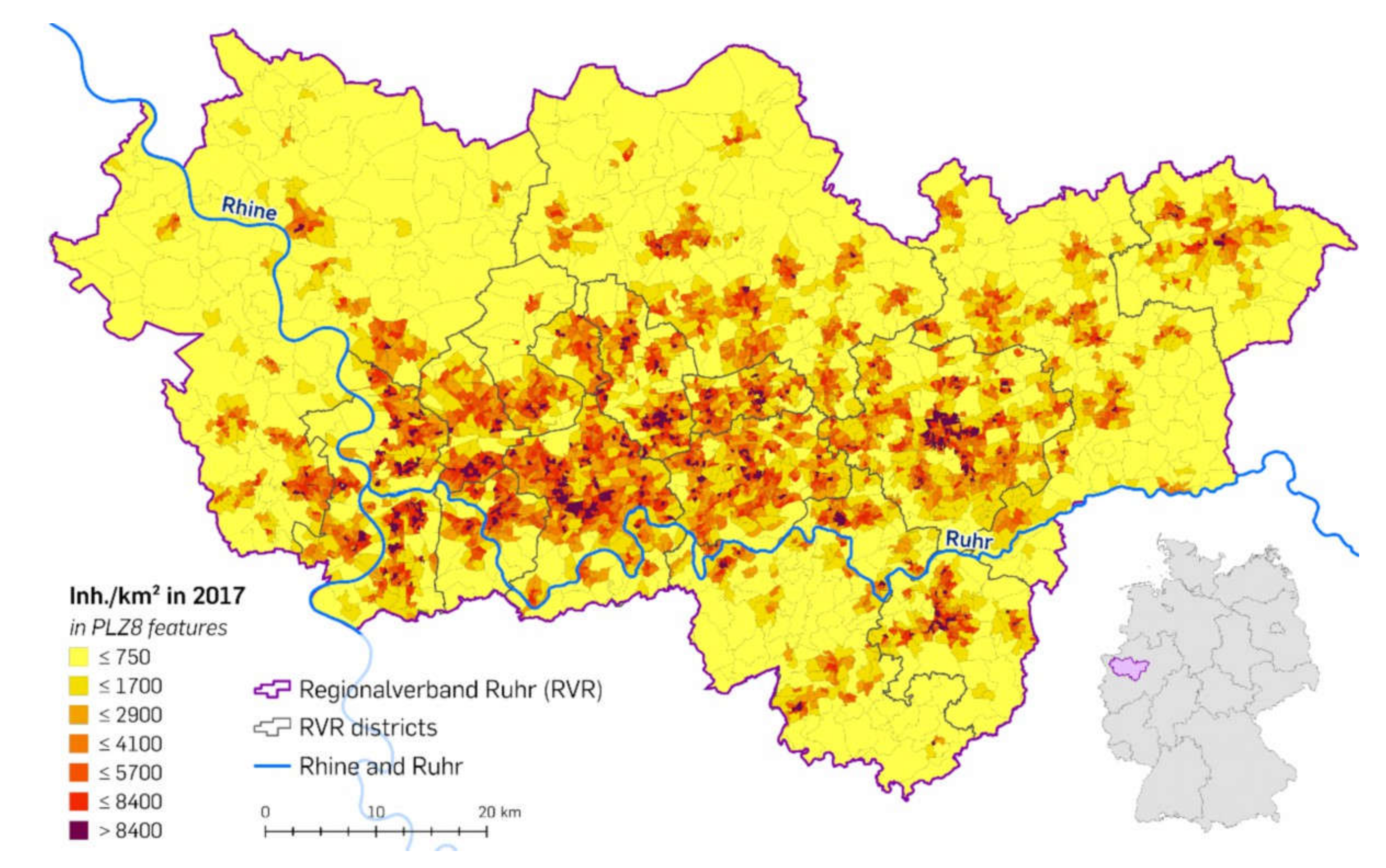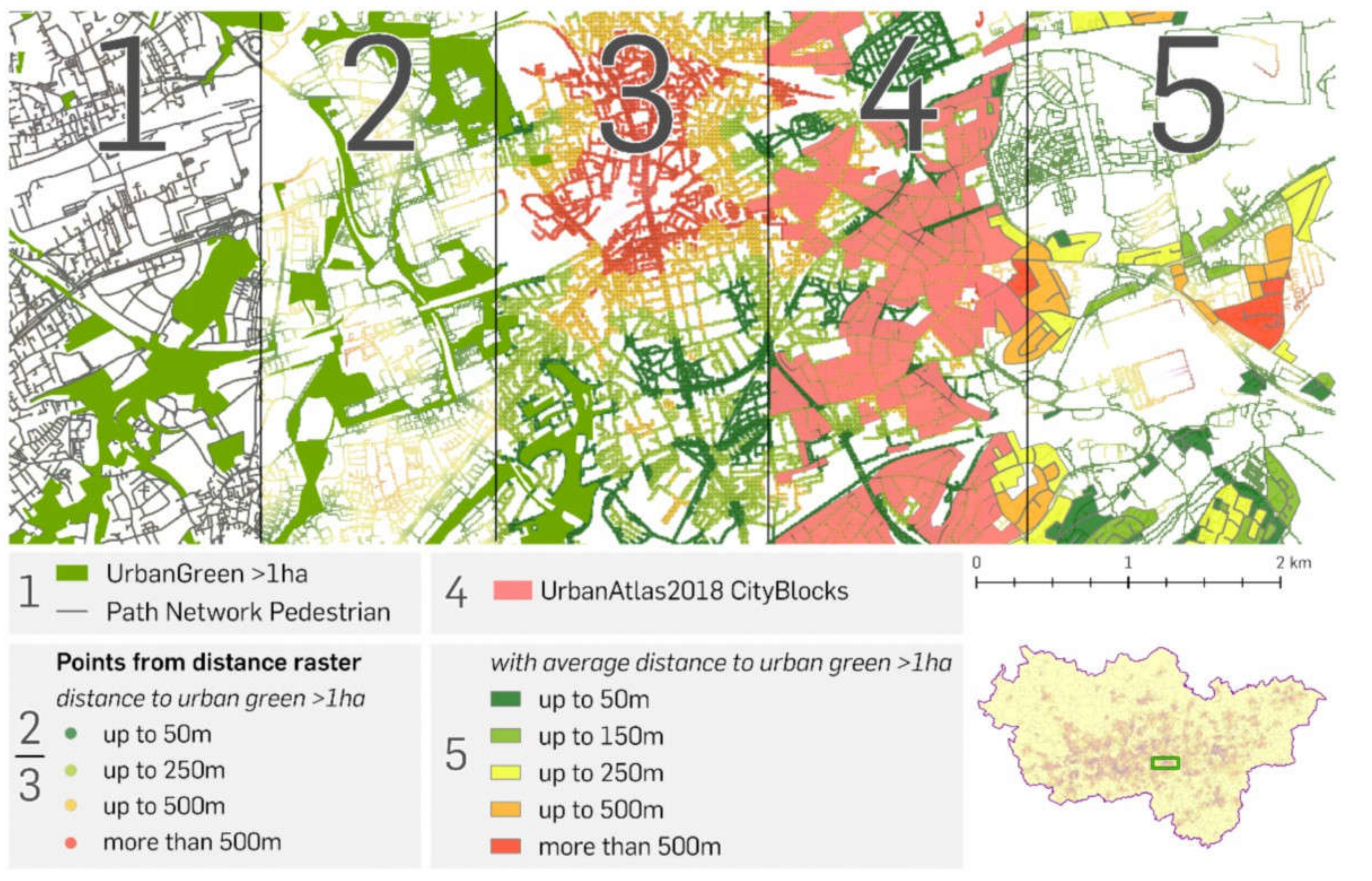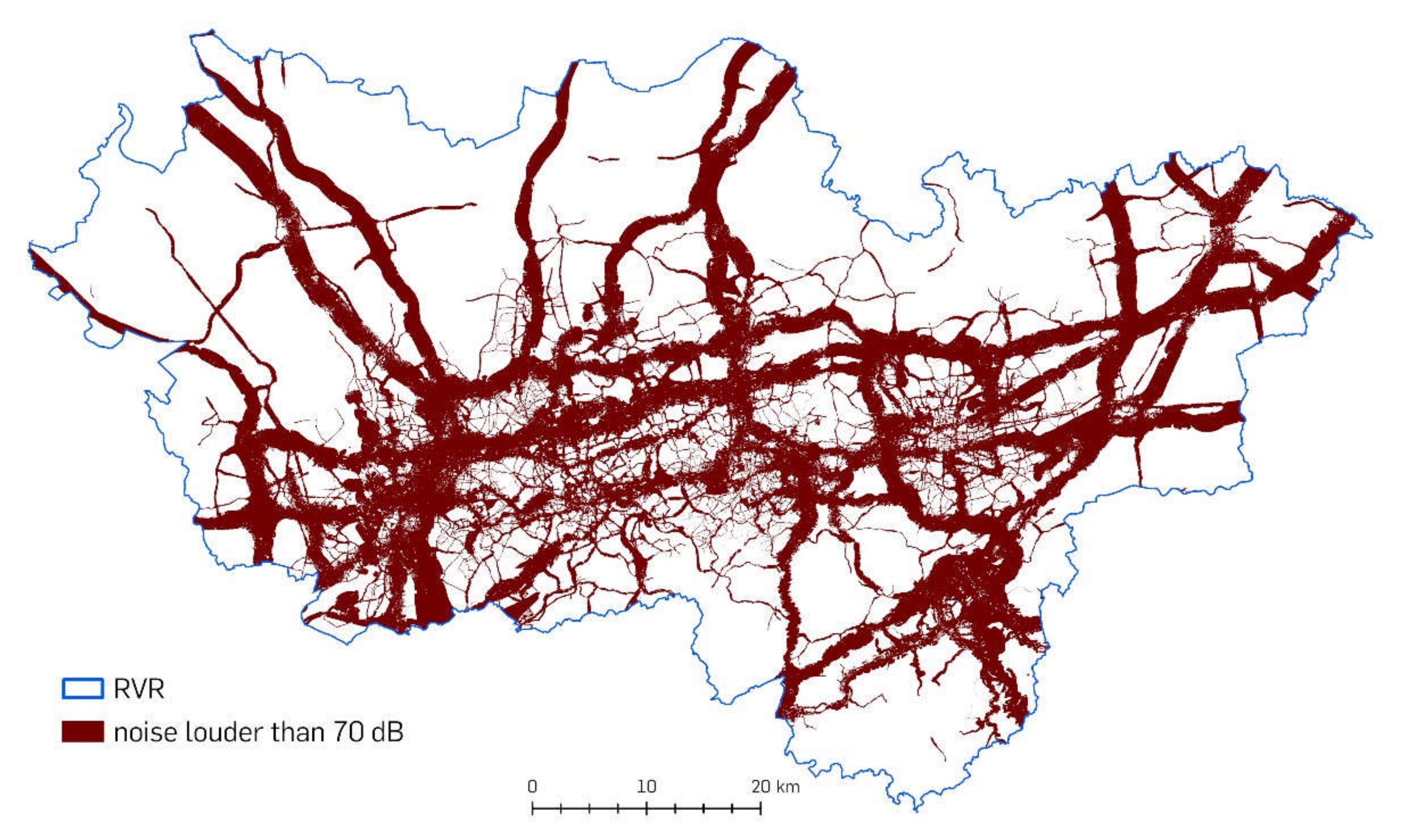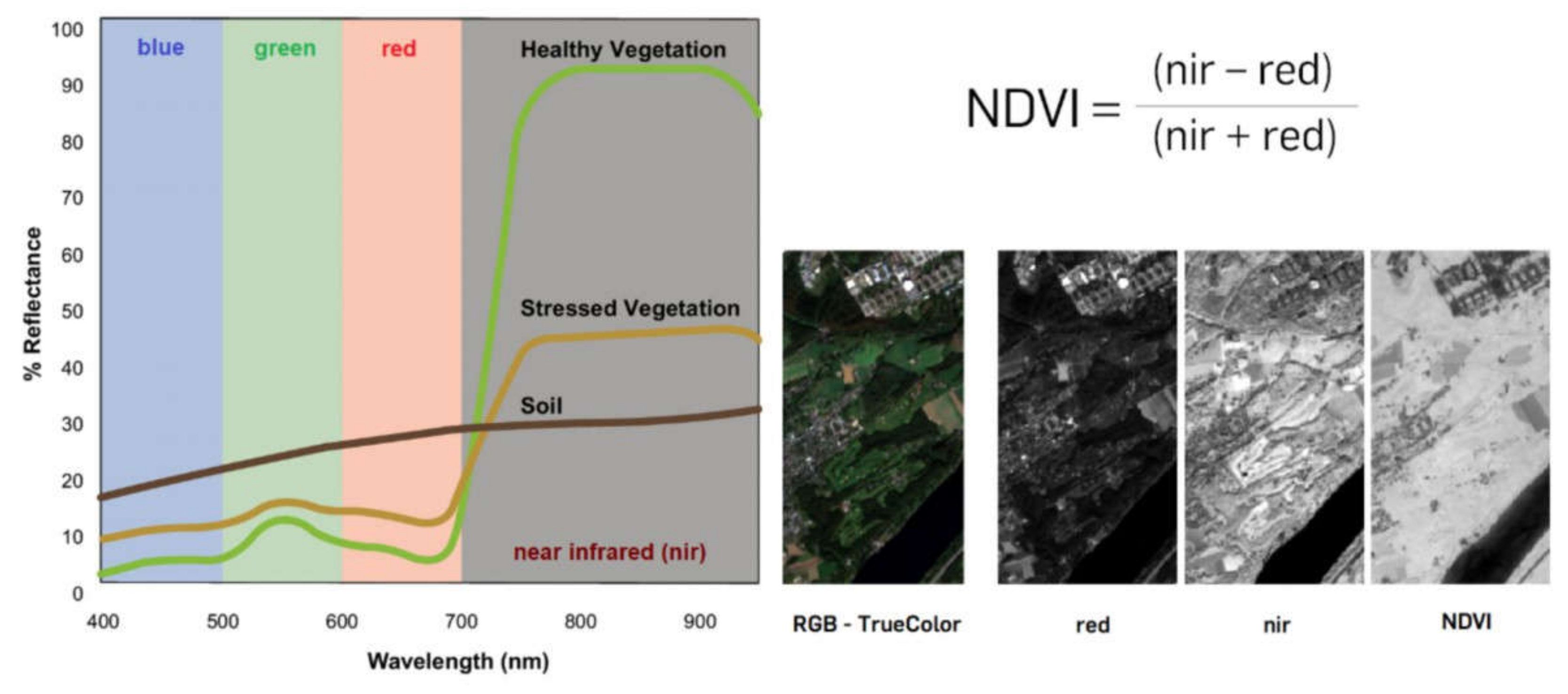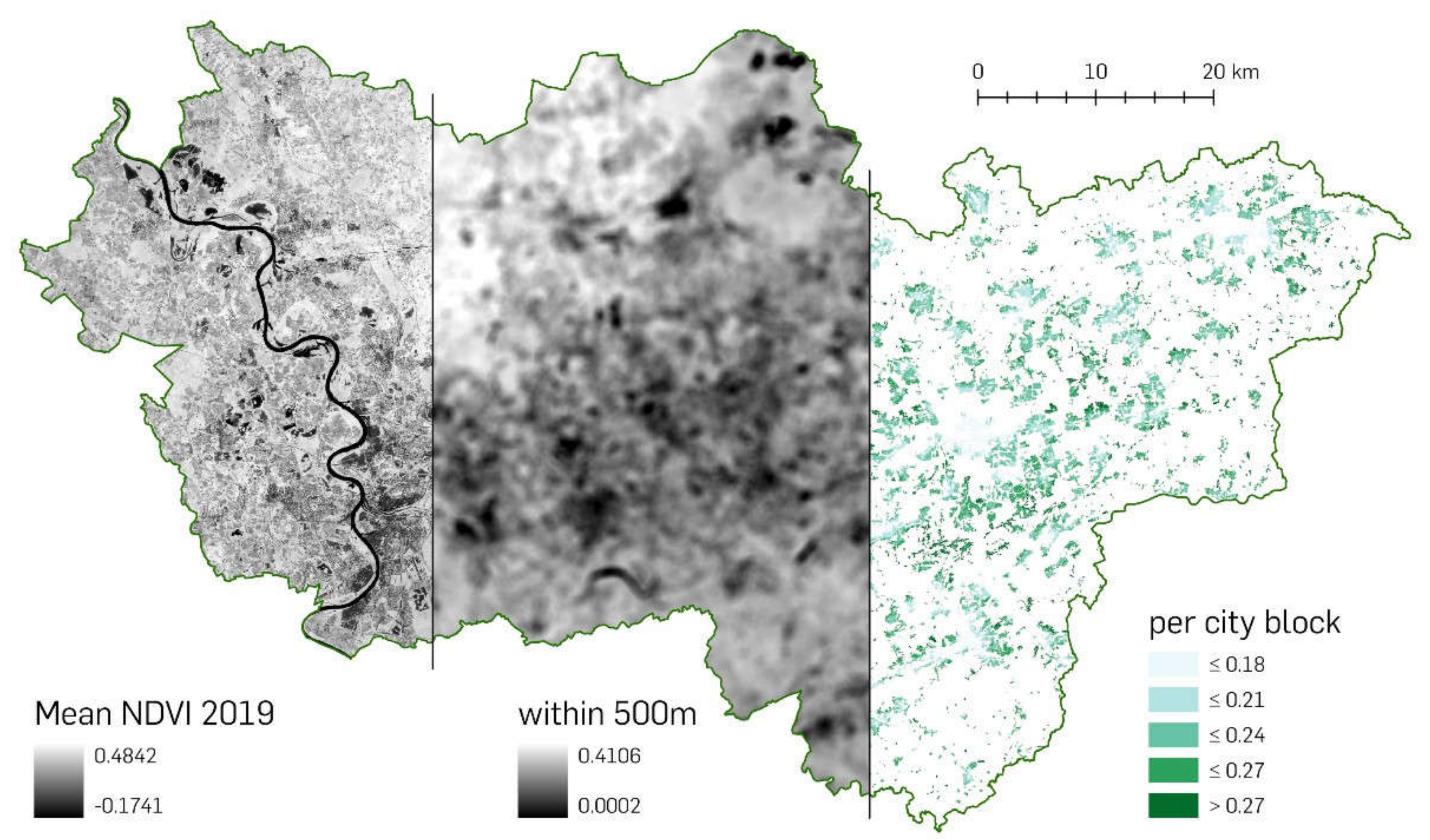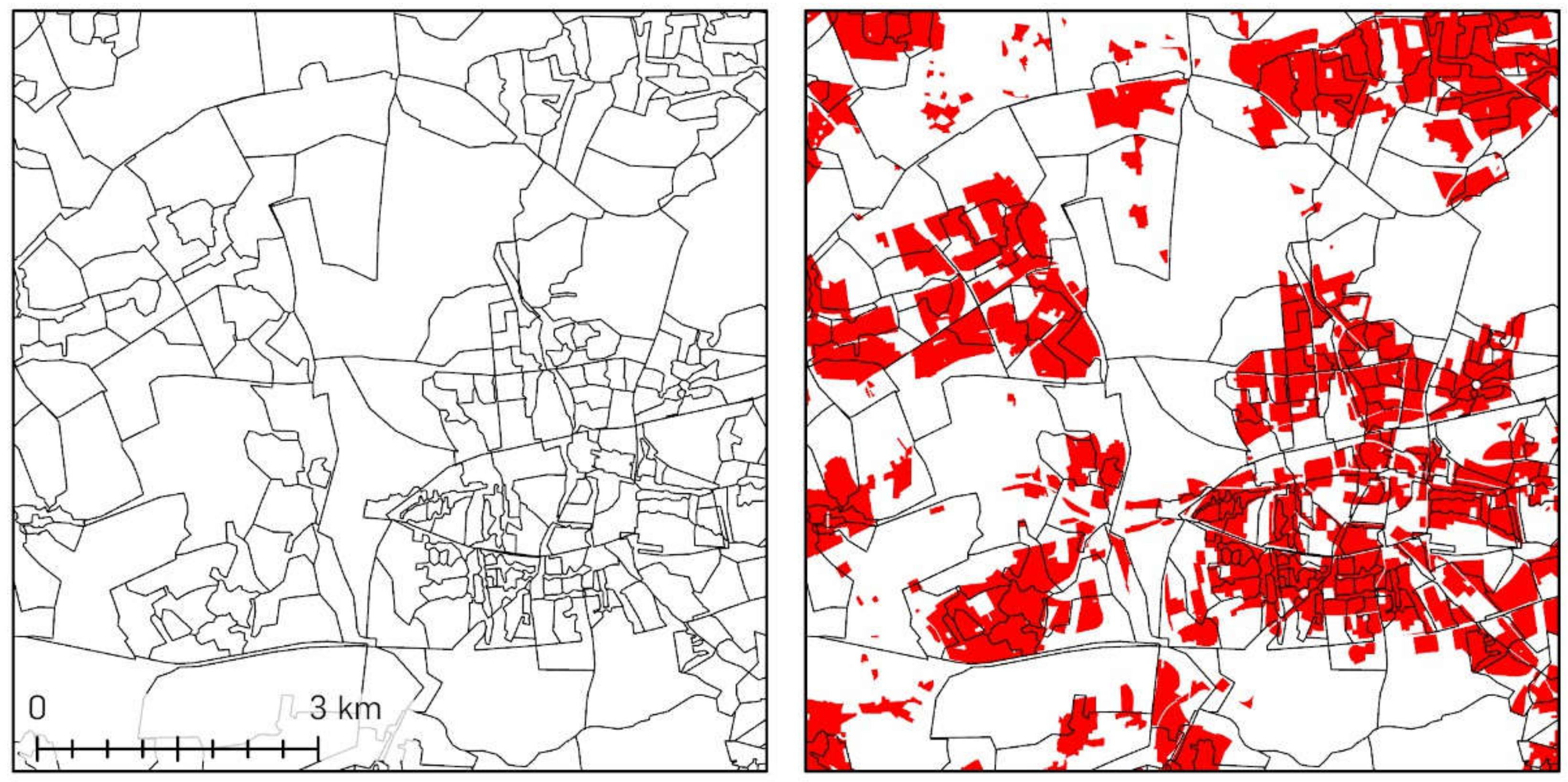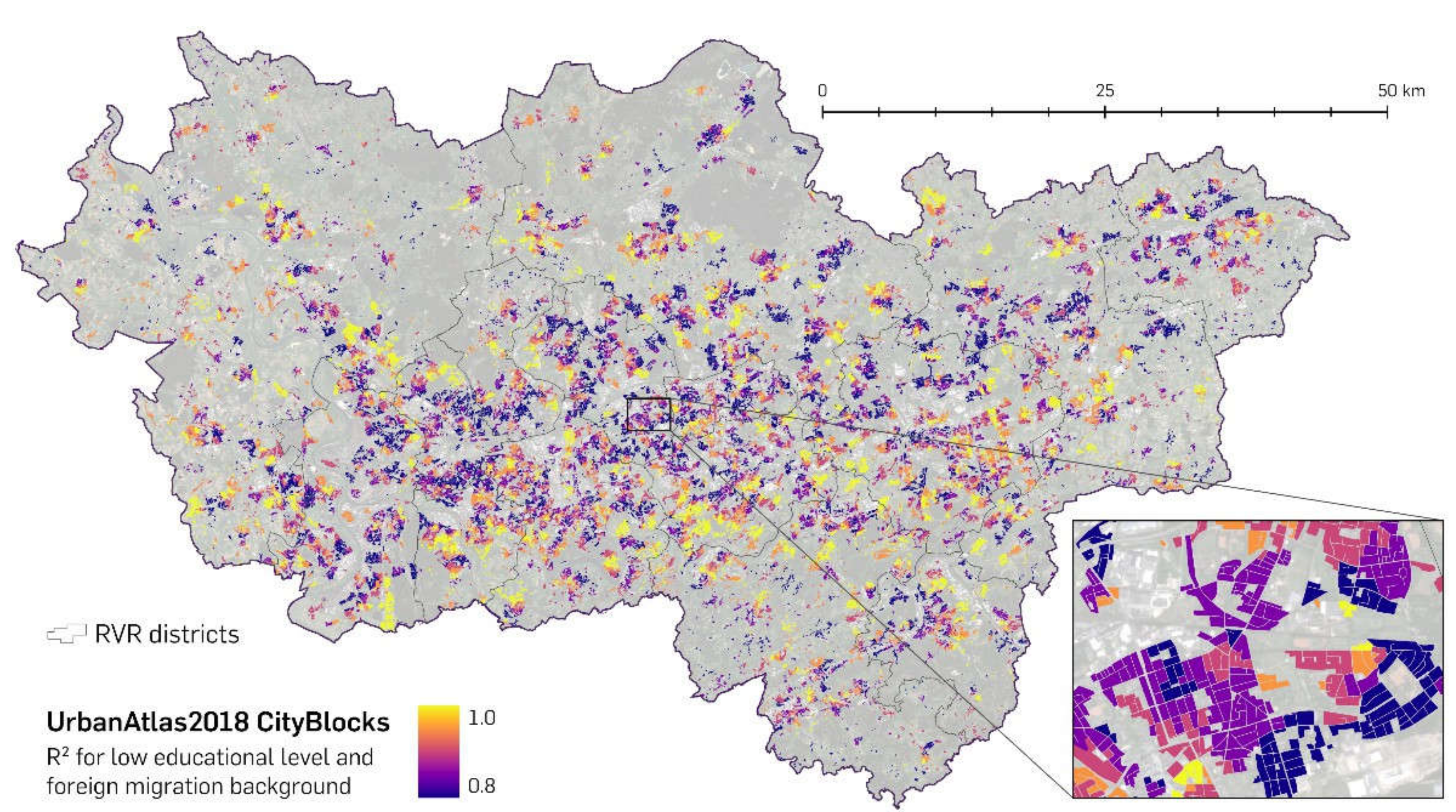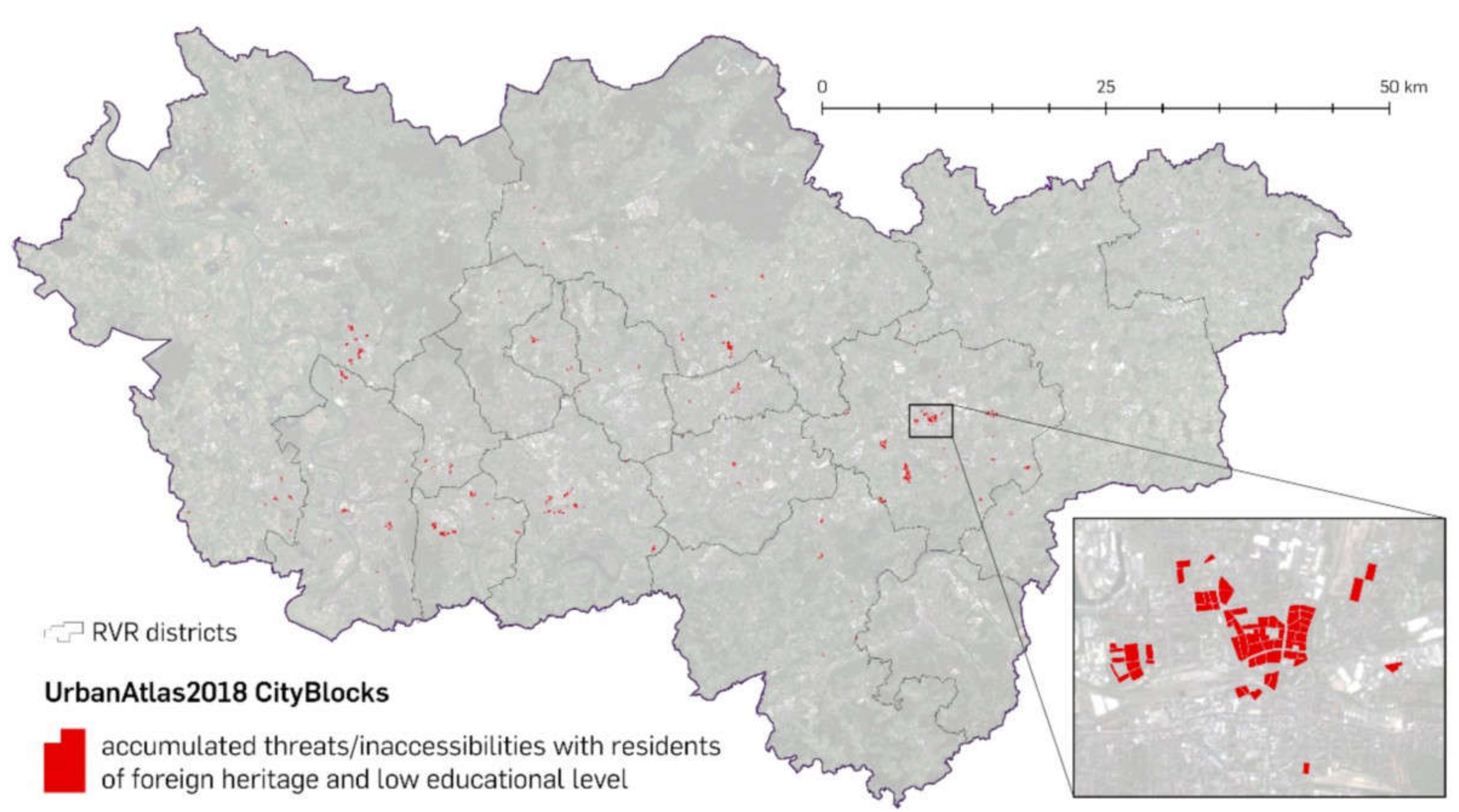Combined Small- and Large-Scale Geo-Spatial Analysis of the Ruhr Area for an Environmental Justice Assessment †
Abstract
:1. Environmental Justice and Sustainability
2. Materials and Methods
2.1. Urban Green Network Analysis Layer
2.2. Areal Interpolation of Mean Annual NO2-Concentrations
2.3. Noise Exposure Measurements
2.4. Average Annual NDVI within 500 m
2.5. Disaggregator and Socio-Economic Variables
2.6. Combining All Data and Performing Correlation
3. Results
4. Discussion
5. Conclusions
Author Contributions
Funding
Institutional Review Board Statement
Informed Consent Statement
Data Availability Statement
Conflicts of Interest
References
- Böhme, C.; Köckler, H. Umweltgerechtigkeit im städtischen Raum: Soziale Lage, Umweltqualität und Gesundheit zusammendenken. In Planung für Gesundheitsfördernde Städte; Baumgart, S., Köckler, H., Ritzinger, A., Rüdiger, A., Eds.; Akademie für Raumforschung und Landesplanung: Hannover, Germany, 2018; pp. 87–100. [Google Scholar]
- Bolte, G.; Bunge, C.; Hornberg, C.; Köckler, H.; Mielck, A.; Aufl, H.H. (Eds.) Umweltgerechtigkeit: Chancengleichheit bei Umwelt und Gesundheit; Konzepte, Datenlage und Handlungsperspektiven; Huber: Bern, Switzerland, 2012. [Google Scholar]
- Grafe, R. Umweltgerechtigkeit. In Umweltgerechtigkeit: Aktualität und Zukunftsvision; Grafe, R., Ed.; Springer Vieweg: Wiesbaden/Heidelberg, Germany, 2020; pp. 25–63. [Google Scholar]
- Flacke, J.; Schüle, S.A.; Köckler, H.; Bolte, G. Mapping Environmental Inequalities Relevant for Health for Informing Urban Planning Interventions—A Case Study in the City of Dortmund, Germany. Int. J. Environ. Res. Public Health 2016, 13, 711. [Google Scholar] [CrossRef] [PubMed] [Green Version]
- McCauley, D.; Heffron, R. Just transition: Integrating climate, energy and environmental justice. Energy Policy 2018, 119, 1–7. [Google Scholar] [CrossRef] [Green Version]
- Banzhaf, S.; Ma, L.; Timmins, C. Environmental Justice: The Economics of Race, Place, and Pollution. J. Econ. Perspect. 2019, 33, 185–208. [Google Scholar] [CrossRef] [PubMed] [Green Version]
- Boone, C.G. Environmental justice, sustainability and vulnerability. Int. J. Urban Sustain. Dev. 2010, 2, 135–140. [Google Scholar] [CrossRef]
- Moos, N. Soziogeomatik: Möglichkeiten und Grenzen der Verwendung von Erdbeobachtungsdaten und Geodaten Zusammen mit Soziodemographischen und Sozioökonomischen Daten. Ph.D. Thesis, Ruhr-University Bochum, Bochum, Germany, 2020. [Google Scholar]
- Raddatz, L.; Mennis, J. Environmental Justice in Hamburg, Germany. Prof. Geogr. 2013, 65, 495–511. [Google Scholar] [CrossRef]
- Klimeczek, H.J. Umweltgerechtigkeit im Land Berlin: Zur methodischen Entwicklung des zweistufigen Berliner Umweltgerechtigkeitsmonitoring. In UMID: Umwelt und Mensch–Informationsdienst; Umweltbundesamt: Berlin, Germany, 2014; pp. 16–22. [Google Scholar]
- Fisher, J.B.; Kelly, M.; Romm, J. Scales of environmental justice: Combining GIS and spatial analysis for air toxics in West Oakland, California. Health Place 2006, 12, 701–714. [Google Scholar] [CrossRef]
- Moreno-Jiménez, A.; Cañada-Torrecilla, R.; Vidal-Domínguez, M.J.; Palacios-García, A.; Martínez-Suárez, P. Assessing environmental justice through potential exposure to air pollution: A socio-spatial analysis in Madrid and Barcelona, Spain. Geoforum 2016, 69, 117–131. [Google Scholar] [CrossRef]
- Herreros-Cantis, P.; McPhearson, T. Mapping supply of and demand for ecosystem services to assess environmental justice in New York City. Ecol. Appl. 2021, 31, e02390. [Google Scholar] [CrossRef]
- Ortiz-Moya, F. Green growth strategies in a shrinking city: Tackling urban revitalization through environmental justice in Kitakyushu City, Japan. J. Urban Aff. 2020, 42, 312–332. [Google Scholar] [CrossRef]
- Nickelsen, J.; Hugot, C.; Bläser, D.; Welling, A.-C. Klimaresiliente Region Weiterdenken: Entwicklungen und Perspektiven für Die Stadtregion Ruhr; Praxispartnerbericht Verbundprojekt ZUKUR: Dortmund, Germany, 2020. [Google Scholar]
- Bramann, F.; Günther, T.; Hofmeister, K.; von der Decken, J. Verbesserung der Umweltgerechtigkeit am Beispiel Alt-Marten: Implementierung Multifunktionaler Grünräume; TU Dortmund University: Dortmund, Germany, 2019. [Google Scholar]
- Moos, N.; Juergens, C.; Redecker, A.P. Geo-Spatial Analysis of Population Density and Annual Income to Identify Large-Scale Socio-Demographic Disparities. ISPRS Int. J. Geo Inf. 2021, 10, 432. [Google Scholar] [CrossRef]
- Jeworutzki, S.; Knüttel, K.; Niemand, C.; Schmidt, B.-J.; Schräpler, J.-P.; Terpoorten, T. Wege zur Metropole Ruhr: Räumlich segregierte Bildungsteilhabe in NRW und im Ruhrgebiet–Zentrale Ergebnisse; Zentrum für interdisziplinäre Regionalforschung (ZEFIR), Ruhr-Universität Bochum: Bochum, Germany, 2017. [Google Scholar]
- microm GmbH. PLZ8: NRW Region. Available online: https://www.microm.de/xpert/daten/lage-und-standortdaten/plz8-raumtypologie (accessed on 22 November 2021).
- microm GmbH. Soziodemografische Variablen NRW. 2017. Available online: https://www.microm.de/fileadmin/microm_Datenhandbuch_2019.pdf (accessed on 22 November 2021).
- BKG. Verwaltungsgebiete 1:250,000 (VG250). Available online: https://gdz.bkg.bund.de/ (accessed on 24 November 2021).
- Cutini, V. Conurbations and resilience. When growth makes us fragile. 5–24 Paginazione/Tema. Methods, tools and best practices to increase the capacity of urban systems to adapt to natural and man-made changes. J. Land Use Mobil. Environ. 2017, 10, 5–24. [Google Scholar] [CrossRef]
- Agyeman, J.; Bullard, R.D.; Evans, B. Exploring the Nexus: Bringing Together Sustainability, Environmental Justice and Equity. Space Polity 2002, 6, 77–90. [Google Scholar] [CrossRef]
- Zhang, M.; Tan, F.; Lu, Z. Resource-based cities (RBC): A road to sustainability. Int. J. Sustain. Dev. World Ecol. 2014, 21, 465–470. [Google Scholar] [CrossRef]
- Jiang, H.; Sun, Z.; Guo, H.; Weng, Q.; Du, W.; Xing, Q.; Cai, G. An assessment of urbanization sustainability in China between 1990 and 2015 using land use efficiency indicators. NPJ Urban Sustain. 2021, 1, 34. [Google Scholar] [CrossRef]
- Rienow, A.; Kantakumar, L.N.; Ghazaryan, G.; Dröge-Rothaar, A.; Sticksel, S.; Trampnau, B.; Thonfeld, F. Modelling the spatial impact of regional planning and climate change prevention strategies on land consumption in the Rhine-Ruhr Metropolitan Area 2017–2030. Landsc. Urban Plan. 2022, 217, 104284. [Google Scholar] [CrossRef]
- Corvalán, C.F.; Kjellström, T.; Smith, K.R. Health, Environment and Sustainable Development. Epidemiology 1999, 10, 656. [Google Scholar] [CrossRef] [Green Version]
- Ozcevik, O.; Brebbia, C.A.; Sener, S.M.; Köckler, H. (Eds.) Sustainable Development and Planning VII. In Proceedings of the Sustainable Development and Planning 2015, Istanbul, Turkey, 19–21 May 2015; WIT Press: Southampton, UK, 2015. [Google Scholar]
- Köckler, H.; Sieber, R. Die Stadt als gesunder Lebensort?!: Stadtentwicklung als ein Politikfeld für Gesundheit. Bundesgesundheitsbl 2020, 63, 928–935. [Google Scholar] [CrossRef]
- Seltmann, G. Die IBA Emscher Park im Kontext der Stadtentwicklungspolitik für Nordrhein-Westfalen. In Zukunft Denken Verantworten; Springer: Wiesbaden, Germany, 2020; pp. 623–629. [Google Scholar]
- Henn, S.; Behling, M.; Schäfer, S. Lokale Ökonomie–Konzepte, Quartierskontexte und Interventionen. Lokale Ökonomie–Konzepte, Quartierskontexte und Interventionen, 1st ed.; Springer Spektrum: Berlin/Heidelberg, Germany, 2020. [Google Scholar]
- Menton, M.; Larrea, C.; Latorre, S.; Martinez-Alier, J.; Peck, M.; Temper, L.; Walter, M. Environmental justice and the SDGs: From synergies to gaps and contradictions. Sustain. Sci. 2020, 15, 1621–1636. [Google Scholar] [CrossRef] [Green Version]
- Eisenmenger, N.; Pichler, M.; Krenmayr, N.; Noll, D.; Plank, B.; Schalmann, E.; Wandl, M.-T.; Gingrich, S. The Sustainable Development Goals prioritize economic growth over sustainable resource use: A critical reflection on the SDGs from a socio-ecological perspective. Sustain. Sci. 2020, 15, 1101–1110. [Google Scholar] [CrossRef]
- United Nations Department of Economic and Social Affairs. The Sustainable Development Goals Report 2021; United Nations: New York, NY, USA, 2021. [Google Scholar]
- Juergens, C.; Meyer-Heß, M.F. Application of NDVI in Environmental Justice, Health and Inequality Studies—Potential and Limitations in Urban Environments; Preprints: Basel, Switzerland, 2020. [Google Scholar] [CrossRef]
- Böhme, C.; Preuß, T.; Bunzel, A.; Reimann, B. Umweltgerechtigkeit im Städtischen Raum–Entwicklung von Praxistauglichen Strategien und Maßnahmen zur Minderung Sozial Ungleich Verteilter Umweltbelastungen: Umweltbundesamt; Umweltbundesamt: Dessau-Roßlau, Germany , 2014. [Google Scholar]
- openstreetmap.org. OpenStreetMap Data Extracts. Available online: Openstreetmap.org/copyright (accessed on 22 November 2021).
- Land NRW. Open Data-Digitale Geobasisdaten NRW. Available online: https://www.bezreg-koeln.nrw.de/brk_internet/geobasis/opendata/index.html (accessed on 30 April 2020).
- European Commission; Copernicus. Urban Atlas. 2018. Available online: Land.copernicus.eu/local/urban-atlas/urban-atlas-2018 (accessed on 22 November 2021).
- Bundesanzeiger. Berechnungsmethode für den Umgebungslärm von Bodennahen Quellen. 2018. Available online: http://www.umgebungslaerm.nrw.de/materialien/gesetze_regelwerke/BAnz_AT_28_12_2018_B700–1_Berechnung_bodenQuellen_BUB.pdf (accessed on 18 November 2021).
- European Space Agency; Centre National d’Etudes Spatiales. Sentinel 2-Imagery. CNES, Paris, Sentinel-Hub. Available online: https://sentinels.copernicus.eu/web/sentinel/home (accessed on 22 November 2021).
- European Union. Mapping Guide for a European Urban Atlas; European Commission: Brussels, Belgium, 2016. [Google Scholar]
- Mau, R. . Erstellung und Aktualisierung der Digitalen Landschaftsmodelle DLM250 und DLM1000; IÖR Schriften 73, 95–102; Rhombos: Berlin, Germany, 2017. [Google Scholar]
- Burian, J.; Pászto, V.; Zapletal, L. Disaggregator—Tool for Aggregation and Disaggregation of Spatial Data; Springer: Berlin/Heidelberg, Germany, 2021. [Google Scholar] [CrossRef]
- Laatikainen, T.E.; Piiroinen, R.; Lehtinen, E.; Kyttä, M. PPGIS approach for defining multimodal travel thresholds: Accessibility of popular recreation environments by the water. Appl. Geogr. 2017, 79, 93–102. [Google Scholar] [CrossRef]
- Neuvonen, M.; Sievänen, T.; Tönnes, S.; Koskela, T. Access to green areas and the frequency of visits—A case study in Helsinki. Urban For. Urban Green. 2007, 6, 235–247. [Google Scholar] [CrossRef]
- Reyes, M.; Páez, A.; Morency, C. Walking accessibility to urban parks by children: A case study of Montreal. Landsc. Urban Plan. 2014, 125, 38–47. [Google Scholar] [CrossRef]
- Rossi, S.D.; Byrne, J.A.; Pickering, C.M. The role of distance in peri-urban national park use: Who visits them and how far do they travel? Appl. Geogr. 2015, 63, 77–88. [Google Scholar] [CrossRef] [Green Version]
- Jalkanen, J.; Fabritius, H.; Vierikko, K.; Moilanen, A.; Toivonen, T. Analyzing fair access to urban green areas using multimodal accessibility measures and spatial prioritization. Appl. Geogr. 2020, 124, 102320. [Google Scholar] [CrossRef]
- Richter, B.; Grunewald, K.; Meinel, G. Analyse von Wegedistanzen in Städten zur Verifizierung des Ökosystemleistungsindikators “Erreichbarkeit städtischer Grünflächen“; Wichmann: Berlin, Germany, 2016. [Google Scholar]
- Grunewald, K.; Richter, B.; Meinel, G.; Herold, H.; Syrbe, R.-U. Proposal of indicators regarding the provision and accessibility of green spaces for assessing the ecosystem service “recreation in the city” in Germany. Int. J. Biodivers. Sci. Ecosyst. Serv. Manag. 2017, 13, 26–39. [Google Scholar] [CrossRef] [Green Version]
- Meinel, G.; Schumacher, U.; Behnisch, M. Regionales kooperatives Flächenmonitoring im Ruhrgebiet: Genauere Daten-Informierte Akteure-Praktisches Handeln; IÖR Schriften, 60, 3-10; Rhombos: Berlin, Germany, 2012. [Google Scholar]
- EU Air Quality Guidelines, Guideline 2008/50/EG; European Parliament and Council: Strasbourg, France, 2008.
- Deligiorgi, D.; Philippopoulos, K. Spatial Interpolation Methodologies in Urban Air Pollution Modeling: Application for the Greater Area of Metropolitan Athens, Greece. In Advanced Air Pollution; Nejadkoorki, F., Ed.; InTechOpen: London, UK, 2011. [Google Scholar]
- Janssen, S.; Dumont, G.; Fierens, F.; Mensink, C. Spatial interpolation of air pollution measurements using CORINE land cover data. Atmos. Environ. 2008, 42, 4884–4903. [Google Scholar] [CrossRef]
- Wilson, J.G.; Kingham, S.; Pearce, J.; Sturman, A.P. A review of intraurban variations in particulate air pollution: Implications for epidemiological research. Atmos. Environ. 2005, 39, 6444–6462. [Google Scholar] [CrossRef]
- Nejadkoorki, F. (Ed.) Advanced Air Pollution; InTechOpen: London, UK, 2011. [Google Scholar]
- World Health Organisation. Health Risks of Air Pollution in Europe—HRAPIE Project: Recommendations for Concentration—Response Functions for Cost-Benefit Analysis of Particulate Matter, Ozone and Nitrogen Dioxide. 2013. Available online: https://www.euro.who.int/__data/assets/pdf_file/0006/238956/Health_risks_air_pollution_HRAPIE_project.pdf (accessed on 18 November 2021).
- Jumaah, H.J.; Ameen, M.H.; Kalantar, B.; Rizeei, H.M.; Jumaah, S.J. Air quality index prediction using IDW geostatistical technique and OLS-based GIS technique in Kuala Lumpur, Malaysia. Geomat. Nat. Hazards Risk 2019, 10, 2185–2199. [Google Scholar] [CrossRef]
- Sadahiro, Y. Accuracy of areal interpolation: A comparison of alternative methods. J. Geogr. Syst. 1999, 1, 323–346. [Google Scholar] [CrossRef]
- Wong, D.W.; Yuan, L.; Perlin, S.A. Comparison of spatial interpolation methods for the estimation of air quality data. J. Expo. Anal. Environ. Epidemiol. 2004, 14, 404–415. [Google Scholar] [CrossRef] [Green Version]
- Assessment and Management of Environmental Noise: Directive 2002/49/EC; European Parliament and Council: Strasbourg, France, 2002.
- Maier, W.; Mielck, A. „Environmental justice“ (Umweltgerechtigkeit). Prävention Gesundh. 2010, 5, 115–128. [Google Scholar] [CrossRef]
- Pettorelli, N.; Vik, J.O.; Mysterud, A.; Gaillard, J.-M.; Tucker, C.J.; Stenseth, N.C. Using the satellite-derived NDVI to assess ecological responses to environmental change. Trends Ecol. Evol. 2005, 20, 503–510. [Google Scholar] [CrossRef] [PubMed]
- Roy, D.P. Investigation of the maximum Normalized Difference Vegetation Index (NDVI) and the maximum surface temperature (Ts) AVHRR compositing procedures for the extraction of NDVI and Ts over forest. Int. J. Remote Sens. 1997, 18, 2383–2401. [Google Scholar] [CrossRef]
- Midopt-Midwest Optical Systems, Inc. NDVI/Agricultural Inspection. Available online: https://midopt.com/solutions/color-imaging/ndvi/ (accessed on 22 November 2021).
- Mutanga, O.; Kumar, L. Google Earth Engine Applications. Remote Sens. 2019, 11, 591. [Google Scholar] [CrossRef] [Green Version]
- microm GmbH. Das Datenhandbuch. 2019. Available online: https://www.microm.de/fileadmin/microm_Datenhandbuch_2019.pdf#c915 (accessed on 15 October 2020).
- Li, T.; Corcoran, J. Testing dasymetric techniques to spatially disaggregate the regional population forecasts for Southeast Queensland. J. Spat. Sci. 2011, 56, 203–221. [Google Scholar] [CrossRef]
- Li, T.; Pullar, D.; Corcoran, J.; Stimson, R. A Comparison of Spatial Disaggregation Techniques as Applied to Population Estimation for Southeast Queensland (SEQ); Monash University: Melbourne, Australia, 2007. [Google Scholar] [CrossRef]
- Mennis, J.; Hultgren, T. Dasymetric Mapping for Disaggregating Coarse Resolution Population Data; Temple University: Philadelphia, PA, USA, 2005. [Google Scholar]
- Wei, Y.D.; Xiao, W.; Simon, C.A.; Liu, B.; Ni, Y. Neighborhood, race and educational inequality. Cities 2018, 73, 1–13. [Google Scholar] [CrossRef]
- Gottschalk, I.; Tepeli, D.A. Etablierten-Außenseiter-Beziehungen im Ankunftsstadtteil Dortmunder Nordstadt. In Die Problematisierung sozialer Gruppen in Staat und Gesellschaft; Springer: Wiesbaden, Germany, 2019; pp. 63–81. [Google Scholar]
- Döring, H.; Kurtenbach, S. Dialog in der Dauerkrise. Einblicke in die Alltagsbewältigung armutsgeprägter Zuwanderung aus Rumänien und Bulgarien in die Dortmunder Nordstadt. In Gesellschaftlichen Zusammenhalt Gestalten; Springer: Wiesbaden, Germany, 2020; pp. 187–217. [Google Scholar]
- Kurtenbach, S. Neuzuwanderer in Städtischen Ankunftsgebieten. Rumänische und Bulgarische Zuwanderer in der Dortmunder Nordstadt; ZEFIR-Forschungsbericht Band 3; Ruhr-University Bochum: Bochum, Germany, 2013. [Google Scholar]
- European Environment Agency. Unequal Exposure and Unequal Impacts: Social Vulnerability to Air Pollution, Noise and Extreme Temperatures in Europe; Publications Office of the European Union: Luxembourg, 2018. [Google Scholar]
- Theofilou, P. Quality of Life: Definition and Measurement. EJOP 2013, 9, 150–162. [Google Scholar] [CrossRef]
- Winiarczyk-Raźniak, A.; Raźniak, P. Are Pueblos Mágicos Really Magic? Tourism Development Program in the Context of the Quality of Life of Town Residents. Land 2021, 10, 1342. [Google Scholar] [CrossRef]
- Glezer, O.B.; Kolosov, V.A.; Brade, I.; Coudroy de Lille, L.; Sluka, N.A. Integrated forms of urban settlement pattern in Russia, Europe, and worldwide. Reg. Res. Russ. 2014, 4, 80–89. [Google Scholar] [CrossRef]
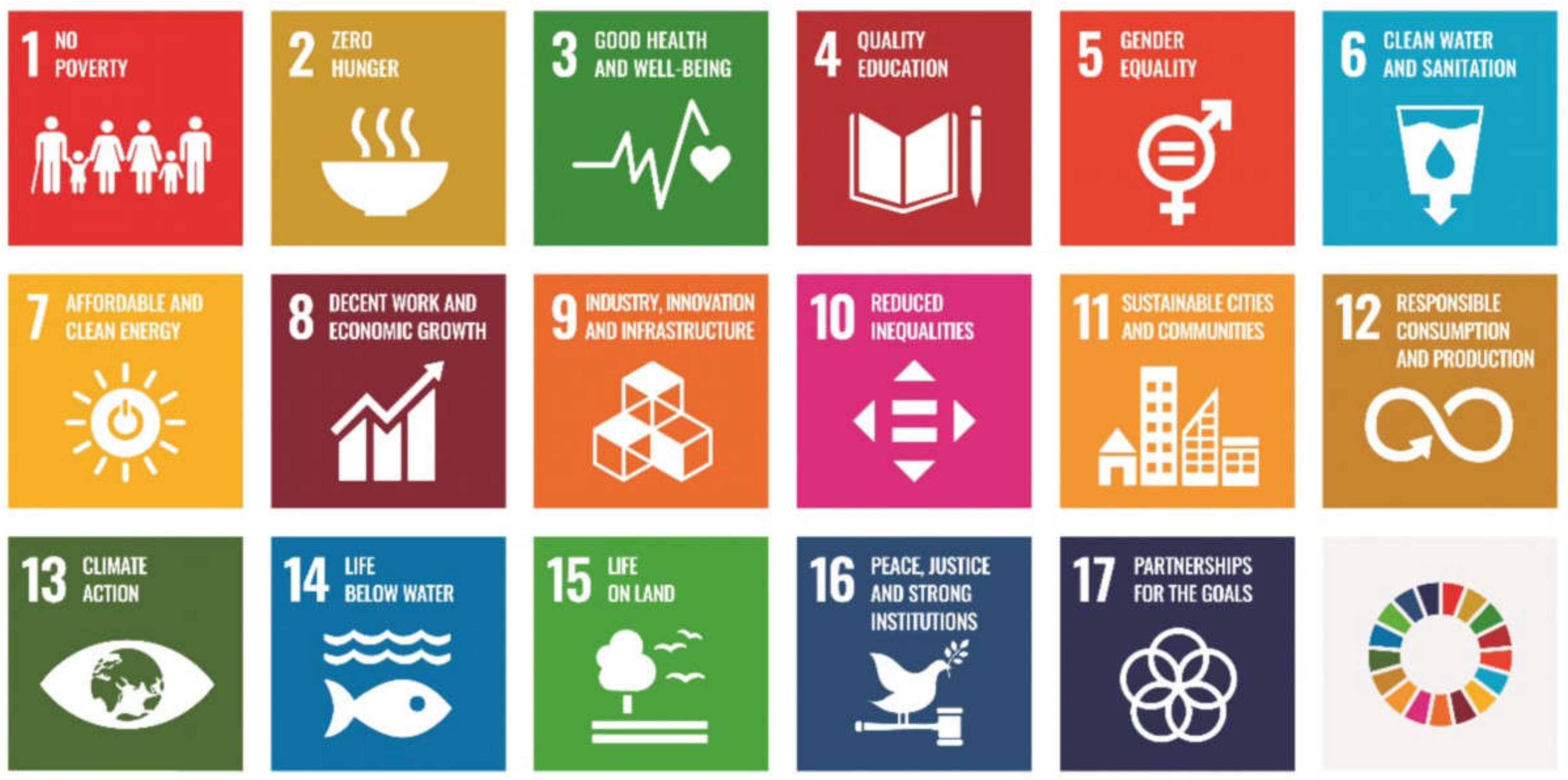

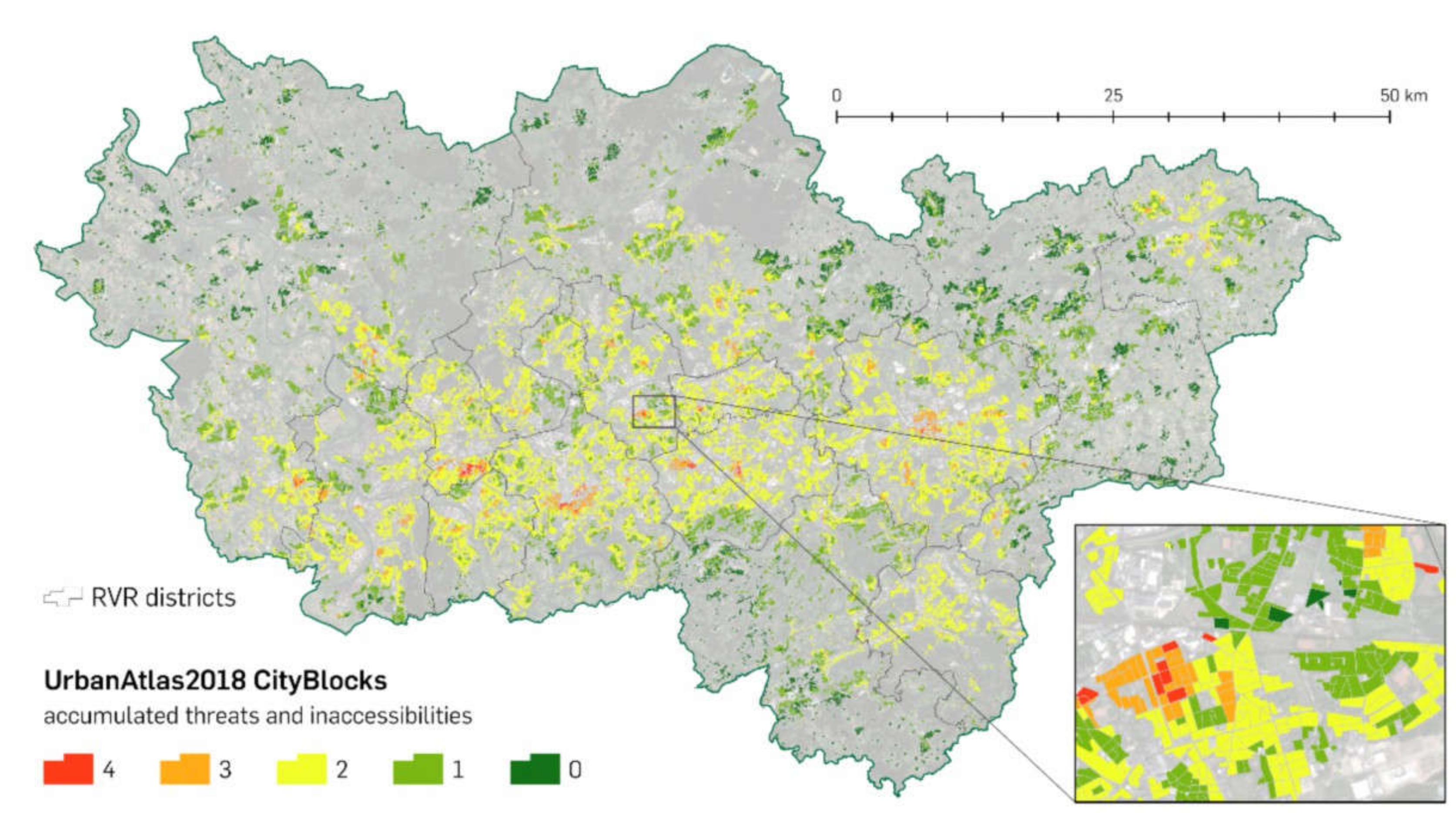
| Data Set | Source |
|---|---|
| Digital Landscape Model (DLM) | Federal Agency for Cartography and Geodesy |
| Urban Atlas 2018 | Copernicus|European Space Association (ESA) |
| Street Network (Pedestrian) | openstreetmap.org |
| NO2—Concentrations from measuring sites | State of NRW |
| Noise map | State Agency for Nature, Environment and Consumer Protection, NRW |
| Socio-economic variables in PLZ8 units | microm Micromarketing-Systems and Consult GmbH |
| Sentinel-2-imagery | Copernicus|European Space Association (ESA) |
| Attribute | Threshold | True | False |
|---|---|---|---|
| urban green > 1 ha | accessible within 500 m by foot | 1 | 0 |
| urban green > 10 ha | accessible within 1000 m by foot | 1 | 0 |
| NO2 concentration | underneath 30 µg/m3 | 1 | 0 |
| noise exposure | underneath 70 dB | 1 | 0 |
| accumulated potential living area (m2) |
| population density (inh./km2) |
| absolute number of inhabitants |
| mean distance to urban green > 1 ha (m) |
| mean distance to urban green > 10 ha (m) |
| mean NDVI within 500-m radius (indexed) |
| mean volume level (dB) |
| mean NO2-concentration (µg/m3) |
| absolute number of inhabitants with a migration background |
| absolute number of unemployed inhabitants |
| absolute number of inhabitants with a school degree lower than high school |
| absolute number of kids (0 to 10 years) |
| absolute number of teenagers (11 to 18 years) |
| absolute number of young adults (19 to 35 years) |
| absolute number of adults (36 to 50 years) |
| absolute number of older adults (51 to 65 years) |
| absolute number of seniors (older than 65 years) |
Publisher’s Note: MDPI stays neutral with regard to jurisdictional claims in published maps and institutional affiliations. |
© 2022 by the authors. Licensee MDPI, Basel, Switzerland. This article is an open access article distributed under the terms and conditions of the Creative Commons Attribution (CC BY) license (https://creativecommons.org/licenses/by/4.0/).
Share and Cite
Moos, N.; Juergens, C.; Redecker, A.P. Combined Small- and Large-Scale Geo-Spatial Analysis of the Ruhr Area for an Environmental Justice Assessment. Sustainability 2022, 14, 3447. https://doi.org/10.3390/su14063447
Moos N, Juergens C, Redecker AP. Combined Small- and Large-Scale Geo-Spatial Analysis of the Ruhr Area for an Environmental Justice Assessment. Sustainability. 2022; 14(6):3447. https://doi.org/10.3390/su14063447
Chicago/Turabian StyleMoos, Nicolai, Carsten Juergens, and Andreas P. Redecker. 2022. "Combined Small- and Large-Scale Geo-Spatial Analysis of the Ruhr Area for an Environmental Justice Assessment" Sustainability 14, no. 6: 3447. https://doi.org/10.3390/su14063447
APA StyleMoos, N., Juergens, C., & Redecker, A. P. (2022). Combined Small- and Large-Scale Geo-Spatial Analysis of the Ruhr Area for an Environmental Justice Assessment. Sustainability, 14(6), 3447. https://doi.org/10.3390/su14063447





